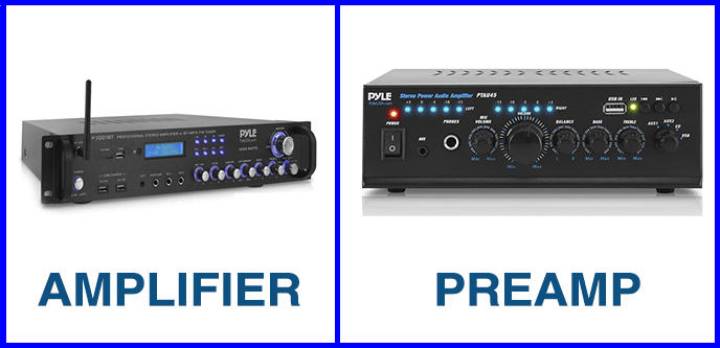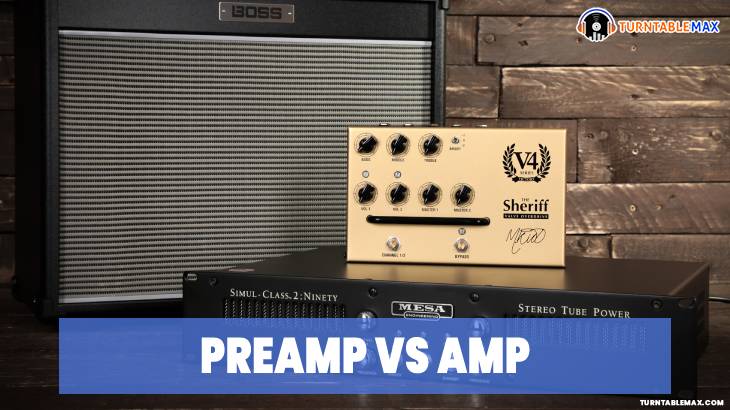If you are an audiophile, who loves to listen to vinyl or turntables, you might have come across the terms amplifier and preamplifier. But who knows what it is exactly? People never pay attention to the technical aspect of the music, like how many components are combined to create sound? or how the sound is processed? The only thing that people are concerned about is how nicely the music is delivered.
If you are an enthusiast and want to know the technical side of sound production, then this post is for you. \
One of the most important aspects of sound is amplification; without it, you can never listen to the sound at an audible level. This is where amp and preamp come into the scenario. Both these terms sound similar, but they perform different functions in an audio system such as a turntable.
If you are a beginner who wants to set up a music studio just for fun or maybe for business purposes, you should be aware of these terms and their differences. So, that’s what you will see in this post.
Differences between Preamp vs Amp
When they both are amplifiers, then on what grounds are they said to be different? Well, that is what we will discuss. The basic difference you have to remember is a preamp boosts weak signals to line level, whereas an amp boosts a line-level signal to further pass it on to the input signal, which will directly be sent to speakers.

By definition
A preamp boosts the weaker signal to a line-level signal, meaning, for example, mic and other acoustic instruments possess weak input signal as compared to digital instruments such as keyboards or electric guitars, which generate a strong signal by default and need no amplification.
Hence, to enhance weak input signals that you can see in some voices, mics, or even acoustic devices and make them equally good as digital instruments. So for these reasons you can use a preamp.
An amp, on the other hand, is used to boost the line signals, which need to be amplified before sending to the speaker. Only then would you be able to listen to the songs or sound at higher volumes. In other terms, amp levels up the signals to the extent a human being can listen to.
To put it simply, a preamp is a mini amplifier that strengthens weak signals and amplifies the signals which were previously enabled by the preamp.
By distortion
This is another significant difference that sets preamp and amps apart. The preamp uses audio compressors to reduce surrounding noise and distortion. Whereas amps do not have such a facility that helps in noise cancellation.
Key Specifications
Price: Amp is expensive when compared to the preamp and the price of it depends on the type of brand you are using. Preamp’s cost depends on the brand as well as its output capacity.
Signal strength: Amp amplifies line-level signals, whereas preamp amplifies weak signals that come before line level.
Power consumption: Amp consumes high power, and preamp consumes low power.
What is a Preamp?
You might wonder what a preamp is used for, or is it even necessary? Preamps do most of the work because preamp is a unit that is designed specifically to improve weak audio signals that come out of microphones or acoustic guitars, etc. Preamp processes them and brings them to line level where they are strong enough to be passed on to the speakers.
Features
- Strengths weak audio signals.
- These are present at the beginning of the signal chain.
- They consume less power
- Suitable for instruments and some home theater systems.
- They can be used individually or can be combined with the main amp.
Sound
You might think preamp has very little to do with sound production but let me tell you, the preamp is the most important component that is responsible for generating the core audio. This core sound can then be manipulated based on the needs of the manufacturer.
In some audio system models, you would see vast differences in the sound quality as well as clarity, and the reasons could be plenty; it could be the distortion or the preamp output capacity.
The thing is, you can only see the difference if you are amplifying instruments that have very little output capacity. If you use it on a home entertainment system, it won’t make much of a difference because your home system is already well amplified.
Sometimes if the preamp is not of good quality, it can distort by causing a fizzy sound that you will get to hear from the speakers. So, choosing the right preamp is very important if you want to avoid distortion or compromise sound quality. Now you know how does a preamp work, it’s time for you to get familiarized with their pros and cons.
Pros:
- Helps in better speaker performance
- Easily transforms low voltage audio signals
- Installation is easy
- Troubleshooting is easy
- Cost-effective and easily accessible.
Cons:
- No control over the audio output
- The number of inputs and outputs are limited
What is Amp?
Amp is also an amplification unit that is designed to regulate weak signals that are generated by the preamp and transform them into strong signals that can be played or heard through passive speakers, turntables, and headphones. Amps are used wherever there are passive speakers because such speakers are not powered or amplified; hence they must be amplified by the amps.
These are used where instruments such as electric drums or electric guitars, or similar equipment are used in the signal chain. The amp transforms the signals coming from this equipment into audible sounds that the audience sitting far away can hear as well.
Features
- Boost the signals that are amplified through the amp.
- Amplifies line signals
- Suitable for instruments such as guitars, electric drums, keyboards, etc.
- These are located just before the speakers in the signal chain.
Sound
This is certainly the most important factor, which is determined by how efficient your amp is and how good your turntable will perform.
If your amp is not good enough, you will never achieve a perfect audio system for yourself. In addition, the sound by amp varies from amp to amp and brand to brand. The power of an amp is well determined when you are using amps for live performances or concerts.
If you use them for home entertainment systems or hi-fi systems, the difference in the sound mostly goes unnoticed. Hence, you should first determine your needs and use the amp accordingly.
Pros:
- Boots audio signals of passive speakers.
- Always used in the majority of audio setups
- It shapes the overall sound production
- It comes in a variety of styles and models
Cons:
- Tend to overheat sometimes
- No noise cancellation
- High power consumption
FAQ
1. Is a Preamp necessary?
Why use a preamplifier? Is it even necessary? Yes, you have to use preamps because the equipment or instruments struggle with weak signal output. In most cases, the preamp comes integrated into the amp itself and very rarely might have to use the amp externally.
2. What’s more important? A Preamp or Poweramp?
The preamp is more important as compared to amp because they initiate the sound production by improving the weak line signals.
3. Can I use a power amp without a preamp?
Yes, you can use a power amp without involving a preamp. This also depends on the type of setup you are using, and if the setup produces low signals, then you might need to use a preamp as well.
Conclusion
Choosing between preamp vs amp for turntable depends on your usage and the setup for which you want to use these components.
If you are looking forward to strengthening a sound system, then you should use a preamp beside an amp. This greatly helps in preventing any damage to the power amp. I hope now you know where to use an amp and where to use a preamp.


